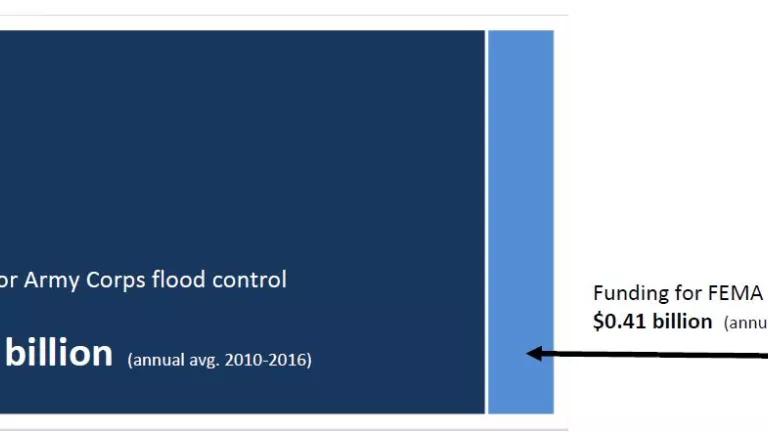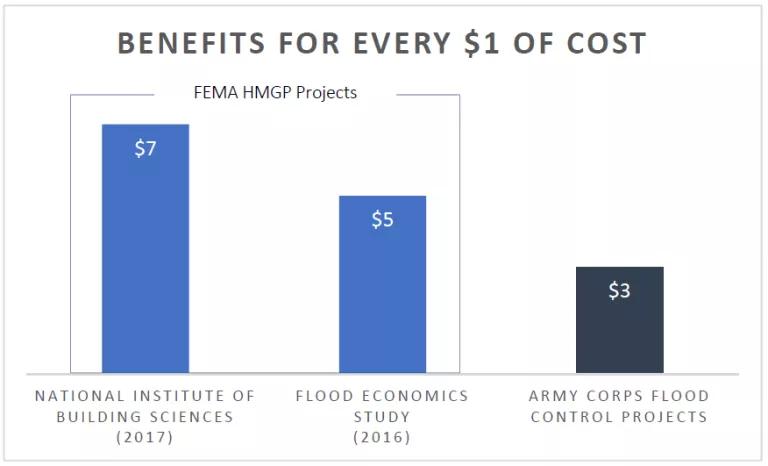
The Army Corps of Engineers budget already dwarfs that of FEMA's Hazard Mitigation Grants Program.
There's an old saying my grandfather used to say to me, "Bad ideas never die, they get endlessly attached to any piece of legislation that has a chance of passing."
Okay, I made that up. My grandfather never said that, but if he had it would certainly be true of two very bad proposals that could setback disaster assistance programs and endangered species protections.
The House has rolled two ill-conceived proposals into the Federal Aviation Administration's re-authorization bill (H.R. 4). Section 609 would allow the Army Corps of Engineers to swipe FEMA funding and build big expensive flood control projects. Section 628 would exempt the National Flood Insurance Program from the Endangered Species Act.
This isn't the first time the House has tried to attach these poison pills to other bills. They tried the same maneuver with the House's disaster appropriations bill. NRDC has worked with a coalition of organizations to convince the Senate to strip these out.
Now, we're back to the same old game.
Section 609 of H.R. 4: Robbing Peter to Pay for Paul’s Massively Expensive Sea Wall
The Federal Emergency Management Agency (FEMA) has a Hazard Mitigation Grants Program that provides money to help owners of flood-prone properties move to safer ground, raise homes that are in low-lying areas, and better design and prepare public infrastructure to weather future storms and avoid damage. But Section 609 of the FAA Re-authorization bill would create a backdoor through which the Army Corps of Engineers could divert these funds from FEMA and use it for short-sighted (and expensive!) flood control projects such as building levees and sea walls, channelizing streams, and rebuilding beaches that are likely to wash away.
This is a monumentally bad idea. FEMA’s Hazard Mitigation Grants comprise a tiny fraction of what the Army Corps spends on levees, sea walls, and other types of flood control projects. Financially, it makes no sense to divert any of FEMA’s already scarce resources to the Army Corps’ relatively large capital budget.
Additionally, the Army Corps’ flood control projects are generally less cost-effective than projects funded through FEMA’s Hazard Mitigation Grants. A study by The Economist Magazine found that for every $1 spent, hazard mitigation projects save $5 in avoided flood damages and losses. A more recent study found the benefits are $7 for ever $1 spent by FEMA on hazard mitigation projects. It’s exceedingly rare to find a project built by the Army Corps that can demonstrate so many benefits for such a small investment.

Projects funded by FEMA's Hazard Mitigation Grants Program are far more cost effective that Army Corps flood control projects.
Section 628 of H.R. 4: Exempting the National Flood Insurance Program from the Endangered Species Act
The second poison pill is a provision that would exempt the National Flood Insurance Program (NFIP) from compliance with the Endangered Species Act, which could have significant ramifications for salmon in the Pacific Northwest and other species around the country threatened by floodplain development.
Under the Endangered Species Act, federal agencies are required to consult with the U.S. Fish & Wildlife Service and the National Marine Fisheries Service when there is a concern about whether an agency’s actions might adversely impact listed species.
The availability of flood insurance influences development of floodplains. As a result, FEMA has a legal obligation to consult with federal agencies about the impacts of floodplain development on protected species and their habitats. Federal courts have agreed with this logic, ruling in at least three instances that FEMA had a responsibility to do just that, including cases in Washington and Oregon that found that FEMA’s implementation of the NFIP adversely impacted endangered salmon. Section 628 would absolve FEMA from ensuring that the National Flood Insurance Program complies with the Endangered Species Act.
Strip these Provisions from the FAA Reauthorization Bill
Congress needs to strip Sections 609 and 628 out of the Federal Aviation Administration's re-authorization bill (H.R. 4).
On their merits, both of these provisions deserve to die yet another death. And, since neither of these has anything to do with the Federal Aviation Administration or its operations, they don't belong in this bill.
But just like my grandfather used to say (not really), these poison pills were attached to this bill because it could pass.



